Football/Soccer Session (Academy Sessions): U16 Technical Session: Passing Patterns (1) (Start Time: 2016-10-24 13:00:00)

Profile Summary

| Name: | Paul Inns |
|---|---|
| City: | Newtown |
| Country: | United Kingdom |
| Membership: | Adult Member |
| Sport: | Football/Soccer |
Description
Passing Drills
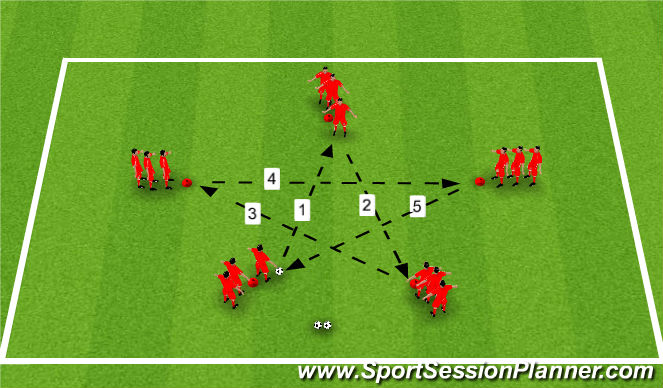
See the guidance at the top of this page to understand why you are not seeing interactive Football/Soccer images.

Barcelona Star (15 mins)
Organisation
Set up grid to a maximum of 25 x 25 yards.
Create Star with cones and split 15 players into 5 x3, placing one group on each cone.
Use 1-3 balls.
Instructions
Players make a pass in the numbered sequence, and follow their pass running straight through the middle of the star - not around it.
Start with one ball until the pattern is learned then work with two balls.
Coaching Points
Eye contact before passing - CRUCIAL
Receive with inside of the foot
Pass with inside of the foot
Firm passing
'Bump Off' the cone into space right when the apss is about to be made. Timing of the movement with the passer is crucial.
Use proper body positiong when receiving the pass.
Create a rhythym to the passing
Progressions
Introduce a second ball, followed by a third.
If a player passes the ball outside the 'Star', that passing player must sprint to get the inaccurate pass - teaches taht an inaccurate pass should be immediately chased after in terms of defending, and instills the good habit - head doesn't go down after a poor pass - go after it with determination.
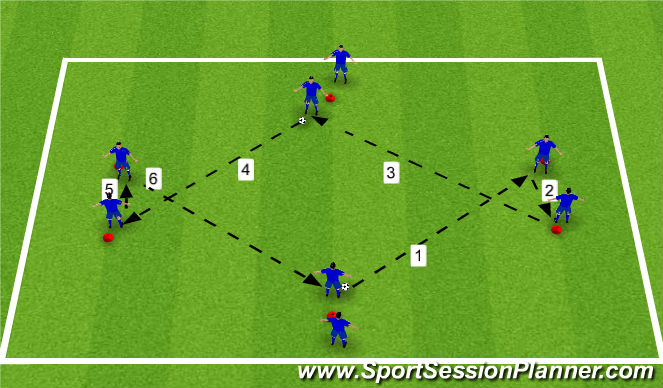
See the guidance at the top of this page to understand why you are not seeing interactive Football/Soccer images.

Beginning Rhythym Pattern (10 mins)
Organisation
Set up cones as above.
8 players - 2 on top and bottom cones - 1 each on remaining cones.
Use one ball to begin until pattern is established, then introduce 2 balls.
Instructions
Players pass in sequence as illustrated, and follow their pass.
Players play one-touch for shorter combination passes in the middle and 2 touch on longer passes.
Coaching Points
Eye contact with receiving player before passing
Receiving Player come off the cone with proper timing. Coordinated movemewnt is essential to make the pattern realistic.
Firm passing to push player's ability and make passing game realistic.
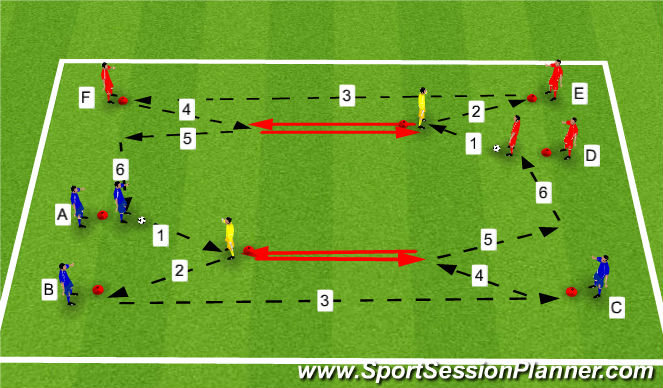
See the guidance at the top of this page to understand why you are not seeing interactive Football/Soccer images.

Triangle & 1-2 Combination Patterns (15 mins)
Organisation
Set up cones as above.
10 players placed on cones as illustrated (can accomodate 12 players)
Instructions
Use one ball to begin, and complete pass 1 at position A to Yellow player.
Yellow player completes pass 2, and rotates, as pass 3 is completed, in order to play 1-2 in opposite corner C.
Play one touch for shorter passes and two touch for longer passes.
After each pass, player rotates one position A to B, B to C, C to D etc.
Coaching Points
Eye contact with the receiving player before passing.
Receiving player come off the cone with propert timing. Coordinated movement is essential to make the pattern realistic.
Firm passing to push player's ability and make the passing game realistic.
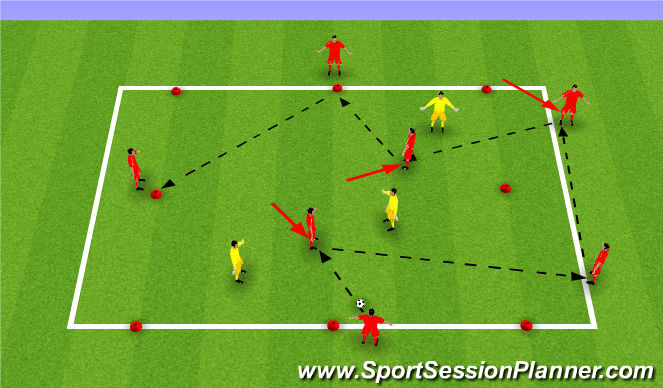
See the guidance at the top of this page to understand why you are not seeing interactive Football/Soccer images.

Overcoming Oppositions Pressure Possession Game (15 mins)
Organisation
Create a grid 25 x 25 yards.
Split players into two teams - 7 red v 3 yellow.
5 red players position themselves on the edge of the square. 3 v 2 in the square itself.
Instructions
Red players seek to retain possession with the help of the two inside players while the yellow players seek to win the ball.
Movement of 2 red players inside the square is key. Go to show; show to go; split; switch.
Red outside players can move from up and down their side and from any side to any other side - subject to the condition taht there can only ever be two players on any one side.
If a red player loses possession, he swaps with a yellow defender.
Coaching Points
Correct body shape
Receive ball on front foot
Control and pass with inside foot
Players should be constantly moving, trying to find the available passing lanes.
Players need to take advantageof the free space created by the numerical advantage.
Progressions
1. Increase number of balls to 2 or 3.
2. Inside players must use 2 touches, so that they have to be aware of the available space in order to make their first touch towards this space; outside players are limited to 1 touch.








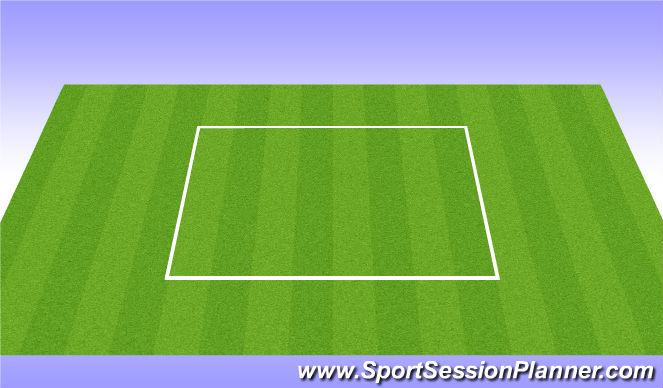
 Play animation
Play animation Play step-by-step
Play step-by-step Repeat (toggle)
Repeat (toggle) Full Screen
Full Screen Pause
Pause Stop
Stop
Introduction
Key Points & Objectives
Passing Patterns are designed patterns which players execute in a set order. The secret is in the detail:
firmness of pass
proper timing and movement of the receiving player
proper body position of the player reciving the ball
proper technique of the passer and receiver
eye contact with receiver before passing the ball
using correct passing and receiving surface - receive on inside/pass on inside
establishing a rythym of play with teammates
executing the drill at a challenging level
remaining focused
Saving a split second is the difference between losing possession or not. If a player isnt positioned properly to receive the ball, it might take an extra half a second to move the ball out of his feet.
Receiving players should come off their cone when the passing player receives the ball and their head is coming up (eye contact before passing the ball is required).
Movement at the right time is the key to creating separation - move too early and you will have ot wait for the ball giving the defender the chance to react.
Firm passing to the correct fott is needed to make the pattern realistic.
If done correctly, players can easily translate the passing movementsw, visual cues, timing and rythym directly onto the pitch if the patterns are done in a realistic way.
Allow groups to race against each other - make every touch count as well as the speed of play. Or, count the number of inaccurate passes within a 3 min block and then repeat to improve.
Practice needs to be deliberate and focussed in order for players to consistently improve.